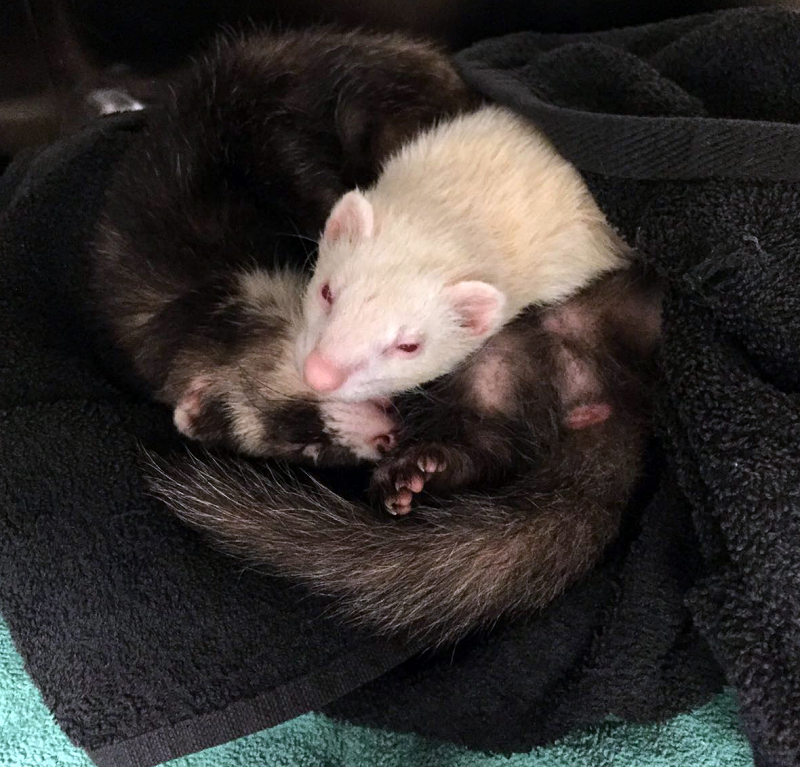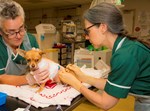Disease risks of ferrets exposed to aquarium water
Two Royal Veterinary College (RVC) exotic species vets and a clinical pathologist are among the authors of a peer reviewed article concerning a ferret becoming seriously ill after repeated contact with an aquarium.
It was such an unusual case that the investigation and article also included experts in human medicine and pathology.
The RVC authors involved in the investigation were Nadene Stapleton and Vicki Baldrey, who both are clinicians at the RVC’s Exotics and Small Mammals Service in Camden, and Clinical Pathologist Laureen Peters.
The three-year-old female spayed ferret developed clinical signs of worsening lethargy, weight loss, muscle wasting, vacant stares and reduced appetite, fluctuating over a period of three months. She had lost a third of her weight and steady weight loss continued.
Prior to this presentation, the ferret was otherwise fit and well with no known medical conditions. Her rapid clinical deterioration necessitated euthanasia shortly after veterinary assessment.
Postmortem testing confirmed Mycobacterium xenopi, which is most commonly identified in amphibians, reptiles and aquatic life. Infection of a captive-bred domestic ferret is highly unusual. This is the second documented case of M xenopi in a ferret, and the first to determine a source of infection.
A collaborative effort involving medical doctors, veterinarians and veterinary pathologists investigated the potential sources of human to animal, animal to animal and environment to animal transmission. No human to animal or animal to animal risks were identified.
As the affected ferret was the only ferret to have regular exposure to the owner’s aquarium, a postmortem study of a dead guppy and aquarium water analysis were performed which confirmed mycobacteriosis. Although M xenopi was not specifically cultured, as a slow- growing organism, M xenopi may have been outgrown by more rapidly growing mycobacteria or Gram-positive bacilli present in the water. Thus, transmission of M xenopi via aquarium exposure was certainly plausible.
Mycobacteriosis is a serious disease in the feral ferret in New Zealand. Elsewhere in the world, cases of both tuberculous and non-tuberculous mycobacterial infections are relatively uncommon, particularly in domestic ferrets. Nonetheless, ferrets are susceptible to a plethora of mycobacterial infections, with the most commonly reported organisms being Mycobacterium bovis, Mycobacterium avium and Mycobacterium triplex.
Mycobacteriosis in ferrets is a polymorphous disease with diverse clinical signs, including coughing, weight loss, lymphadenopathy, intermittent anorexia, vomiting and mild diarrhoea. Treatment of mycobacteriosis in ferrets is problematic due to the hardiness of this bacterium and the extent of dissemination by the time a diagnosis is determined. Due to the disease’s poor prognosis and largely ineffective multiple antibiotic treatment regimens to date, the disease is considered to be fatal in ferrets and euthanasia is recommended on diagnosis.
Water is recognised as its prime reservoir of M xenopi and the bacterium has been identified in water supplies in homes and hospitals. M xenopi is recognised as a cause of pulmonary disease in humans and is frequently isolated from immunosuppressed patients or individuals with pre-existing lung disease.
Due to the paucity of literature regarding this organism in cross-species transmission, the possibility of human to ferret or ferret to human transmission could not be excluded. As domestic ferrets tend to live in close proximity to their owners, transmission of infectious agents between human beings and ferrets is plausible. In humans, M xenopi is usually contracted from the environment and thus it would also be feasible for a ferret to contract this infection from a contaminated environmental source.
The ferret owner underwent assessment by a GP doctor, respiratory nurse specialist and respiratory consultant to investigate for possible active or latent mycobacterial infection (tuberculous and non-tuberculous). 11 other people who had contact with the ferret agreed to participate in a comprehensive survey. All were asymptomatic and the survey identified no plausible risk of transmission of mycobacterium from human contacts to the ferret.
Four companion ferrets that shared the same living space as the affected ferret underwent full veterinary clinical assessment and chest and abdominal x-rays. ‘High-risk’ ferrets that shared the same cage as the affected ferret underwent additional routine blood tests.
The affected ferret used to climb furniture to submerge its head in the water and also drink the water. None of the other ferrets in the household expressed any interest in the aquarium or sustained similar exposure.

The case highlights the dangers of ferrets having any contact with potentially infected water reservoirs. This is because of the fatal nature of this disease, the susceptibility of ferrets and the lack of effective treatment options to date. A history of exposure to water reservoirs containing aquatic or amphibious life, including domestic aquaria, should be routinely sought during the veterinary examination of sick domestic ferrets.
The article, published by Veterinary Record and can be read online via this link.
You may also be interested in:
-
Registered Veterinary Nurse celebrates 30 years of service at the RVC
Katie Bacon, a Registered Veterinary Nurse (RVN) at the Royal Veterinary College (RVC), is …

